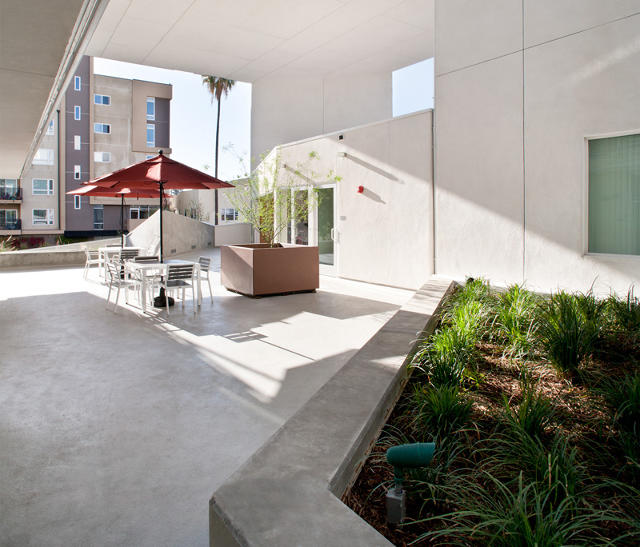Designed by Brooks +Scarpa, The Six offers housing and support services to one of the city's most vulnerable populations.
With an estimated 43,000 people living in shelters or on the street, Los Angeles has the nation's largest population of homeless individuals. Additionally, the city also has the most homeless veterans—an estimated 2,700. The problem is complex and nuanced, but The Six, a new, 52-unit supportive housing project in MacArthur Park, a neighborhood west of downtown, aims to chip away at the epidemic.
Designed by the local architecture firm Brooks + Scarpa, The Six was commissioned by the Skid Row Housing Trust, an organization that provides permanent residences for homeless individuals and has served over 1,800 people since its founding in 1989. Most of its work has been concentrated in Skid Row—the epicenter of L.A.'s homeless epidemic—where the organization has provided permanent housing in renovated buildings and new construction, like the Michael Maltzan-designed Star Apartments. The Trust's model emphasizes the need for supportive services—like substance abuse counseling, health care, mental health care, and community building—alongside housing. The Six, which recently earned an honor award from the AIA, is its first project outside of the neighborhood.
"The Skid Row Housing Trust comes from a place where they believe good design promotes the healing and social well-being of people in their buildings,"Angela Brooks, an architect and managing partner at Brooks + Scarpa, says. "It's about having quality design that instills a sense of dignity."

Bound by a tight budget, the architects at Brooks + Scarpa incorporated design gestures that would offer the biggest bang for their buck, which meant incorporating as much natural light and air into spaces as possible and keeping a fairly simple silhouette—knowledge the firm has gained from developing previous affordable housing projects, like Step Up on Fifth and Rosa Gardens.
"It's a simple box; it's not like a wedding cake," Brooks says. "When you do that, you have to add more structural beams and waterproofing. If you stay away from that, you get more architecture for the money. Every units stacks. All the windows are the exact same size, there a nice proportion, and the patterning is important. But in terms of construction, cost it's really really small. There are certain lines we don't cross because we know the budgets are cast in stone and don't move."
There aren't any fancy finishes—most of the building is clad in stucco—nor are there any superfluous flourishes, and ambitious geometries, but the studio apartments all have cross ventilation, which helps reduce the need for air conditioning, and tall windows so daylight can permeate the interiors. The ceilings are extra high to increase the feeling of spaciousness. All of the rooms and bathrooms are wheelchair accessible. Residents can freely use a communal "living room" and computer lab, or retreat to an interior courtyard on the second level or rooftop garden, which is serves for the health and wellness of the residents.

While the building was designed for a specific population—disabled homeless veterans—the architects approached the project using principles of good design that are universal. One of them is the notion of defensible space, which applies to many design projects but can become especially important when working with veterans—with whom PTSD is common. When the designers first presented the original concept to the homeless vets the Skid Row Housing Trust serves, they learned that a proposed courtyard directly connected to the street by a monumental staircase wasn't desirable. (Weaving the building into the neighborhood was a priority for the architects.) They wanted the visual connection, but not so much a direct spatial one, since it made the space feel vulnerable, not safe and secure. They went back to the drawing board and changed the circulation so that there was less transparency.
"It became a bit more defensible in design and plan," Brooks says. "They want to know what's around them, they want to fee safe, they don't want to feel vulnerable. But when we design, we use good design that's common to all."
The building celebrated its grand opening last April and all of the units are occupied as of November 2015. To finance the project, the Skid Row Housing Alliance used a combination of local and federal funds including Section 8 Project-Based Vouchers—a program for very low income families and individuals—from the Department of Housing and Urban Development (HUD) via the Housing Authority of the City of Los Angeles for 50 units. The Trump Administration has already cut HUD programs, including a tax break for middle-class homebuyers, and it remains uncertain how other programs, like Section 8, will fare. Ben Carson, who was nominated to lead HUD but has not yet been confirmed, has been vocally critical of the Fair Housing Act, which protects against discriminating disabled individuals. The Trump Administration's policies pertaining to HUD and its funding could jeopardize future low-income developments, like the Six.
Brooks is proud about what a project like this embodies and signals about the greater social responsibility to shelter people. "It's this idea that good design is a basic civil right and everyone deserves good design," she says. "This idea that we would put people in a building that's badly designed is un-American. People have a right to live in a place that lifts their spirits, especially Veterans."
[Photos: Tara Wujcik/via AIA]